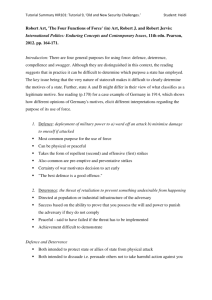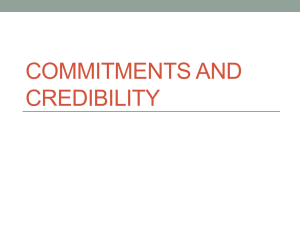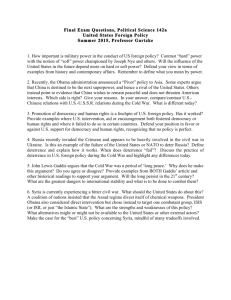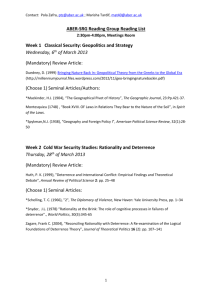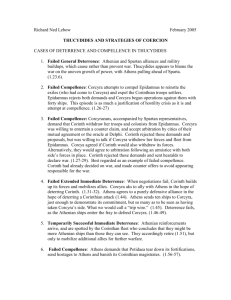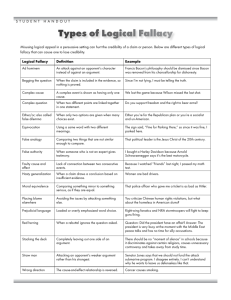The Use of Force
advertisement
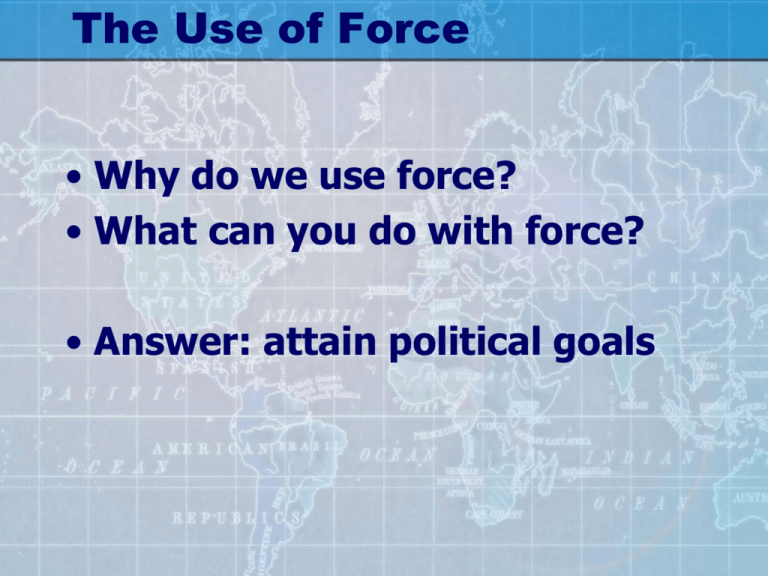
The Use of Force • Why do we use force? • What can you do with force? • Answer: attain political goals The Functions of Force 1. 2. 3. 4. Defense Deterrence Compellence (coercive diplomacy) Swaggering Based in part on: Sources • Thomas Schelling. Strategy of Conflict (Cambridge: Harvard University Press, 1960). • Thomas Schelling. Arms and Influence (New Haven: Yale University Press, 1966). • Alexander George, David Hall, William Simons. The Limits of Coercive Diplomacy (Boston: Little, Brown and Co., 1971). • Robert Art. To What Ends Military Power? International Security Vol. 4, No. 4 (Spring, 1980), pp. 3-35. • Herman Kahn. On Escalation (NY: Penguin, 1965). 1. Defense Defense at its most complex Defense at its most basic 2. Deterrence • Goal: To prevent action • Method: Threat • Aimed at influencing an opponent’s decision making • Assumption: rationality Rational Choice Cost Benefit Analysis Options A Costs ? Benefits ? B ? ? C ? ? Threat: increases perception of costs Types of Deterrence Deterrence by Punishment Deterrence by Denial Communication Europe during the Cold War China and Taiwan Credibility and Reputation • Capability • Will • A bluff? Extended Deterrence • • • • • • • Europe Japan S. Korea Israel Taiwan Australia New Zealand What to Threaten? Irrationality? Saddam Hussein Kim Jong-un • If deterrence fails…. 3. Compellence (coercive diplomacy) • Goal: To change opponent behavior • To stop an opponent from doing something they are doing • To get an opponent to do something they are not doing Basic Elements 1. 2. 3. 4. Brute force won’t work Assumes rationality War is bargaining The power to hurt allows you to enter the bargaining 1. Brute force won’t work 2. Assumes Rationality Cost Benefit Analysis Options A Costs ? Benefits ? B ? ? C ? ? 3. War is Bargaining 4. Entering the Bargaining? • The power to hurt • Capability • Intentions Some Lessons 1. Shadow of the Future 2. It doesn’t always work 3. Commitment 4. Credibility 5. Democracies and Compellence 6. Balance of Commitment 7. Non-state Actors 8. Civilians 9. Uncertainty and Risk 10.Domestic Politics 11.Irrationality? 1. Shadow of the Future • What coerces? • The promise of future violence 2. It doesn’t always work Compellence Success • Cuban Missile Crisis Compellence Failure • F-105s over Vietnam 3. Commitment • Berlin Airlift 1948 4. Credibility A. Continue the pain Credibility B. Interdependence of credibility and commitment • Reputation • Was Vietnam about Europe? • “Doctrine of Credibility” 5. Democracies • Poor at compellence? • Vulnerable? 6. Balance of Commitment Vietnam War Balance of Commitment Ukraine 7. Non-State Actors • Two Eras A. Cold War • Insurgencies and Marxist ethnonationalist terrorists • Vietcong • Palestinian Liberation Organization (PLO) Non-State Actors B. Post-Cold War: • Network organizations living off of globalization • Not state sponsored • • • • AQAM Boko Haram ISIL Al-Shabab 8. Civilians Dresden, Feb 1945 World Trade Center 9. Uncertainty and Risk •Competition in risk taking •Brinkmanship •“The Threat That Leaves Something to Chance” • Escalation • Herman Kahn 10. Domestic Politics and Compellence The Politics of the Target Iranian President Hassan Rouhani Iranian Ayatollah Ali Khamenei Dilemmas • Irratioality • Perceiving message • Can the opponent do what you ask? 4. Swaggering • The Great White Fleet 12/07-2/09
